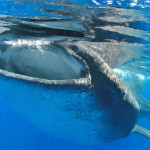
Speaking of incredible deep-working freshwater robots (Texas rocks), LA Times Science section has a great story on the Canadian underwater lumberjacks at Triton Logging. Inc. The enterprise has developed a remote-controlled chainsaw-wielding submarine called the Sawfish to harvest cedar, pine, spruce and Douglas fir from water 200 foot deep in freshwater reservoirs created by dam construction.
Triton’s founder claims 45,000 untapped submerged forests exist in the world, and he’s developing a fleet of remote controlled submersible chainsaws to harvest them.
The whole operation is apparently eco-friendly.
“We don’t disturb fish habitat,” founder and Chief Executive Chris Godsall points out, because an underwater forest is not a natural marine habitat.





The rationale, “an underwater forest is not a natural marine habitat,” sounds fishy (sorry). If underwater forests are healthy fish habitats, then their naturalness is irrelevant, and this practice harms those fish habitats. I’d much rather we cut down underwater forests than dry land forests, but I’d bet this isn’t an either/or proposition, and that we’re just adding underwater deforestation to the sum total of global habitat loss.
What an incredible picture!
How long does wood last for underwater, though? Maybe longer than I’d have guessed…
Apparently the wood is effectively preserved for thousands of years because cold, oxygen poor water presumedly limits microbial activity.
It’s “eco-friendly” in that it extracts shareholder value from environmental damage that has already been done. Calling it “not a natural fish habitat” is true only if they admit it’s “a natural tree habitat”.
Now, I say “already done”, but if the profit to be extracted from harvesting the trees drowned by a dam is calculated in as part of the decision to dam the forest, then it’s not already done: it’s a part of the act itself.
Corporations have centuries of experience breaking up the bits of what they do and having their human components be “not responsible” for that bit. This sounds like more of the same.
Any fresh water fisherperson knows that you look for a submerged treefall area because that is where the fish hang-out, so please do not try to say that this is not a natural habitat. Also, young fish use just this type of cover to stay safe from larger feeding fish.
Just another excuse to line someone’s already full cash pocket.
Excuse me, I thought this was a serious story.
Submerged wood becomes waterlogged. Faster, when deeper, warmer, or more saline. Nevertheless, even cold fresh shallow water can do it in a couple of years.
If these trees were not in fact too waterlogged to use even chipped for hog fuel, they would shoot to the surface like spears.
I have personal experience of fishing Williston Lake, behind Bennett Dam in B.C., both soon after its creation and many years later. Lodges on the shore of the lake still display pictures of punctured vessels, some quite substantial house/party boats.
This story is a PR boondoggle. All I really care to find out is; whose?
The LA Times story states the recovered wood is kiln dried, and architectural grade.
People are already recovering logs that were sunk in Lake Superior at the end of the 1800s. The wood is of such good quality that even with the expense of bringing it up and drying it out there is a lot of money to be made.
http://www.american.edu/projects/mandala/TED/SUNKWOOD.HTM
Just a few facts from us at Triton which may help clarify:
Habitat Protection – Triton does not harvest shorelines, river mouths or areas on which fish depend for protection or nesting. Where we harvest (deeper water with large, bald tree trunks) generally do not serve these purposes. We also repatriate branches (for reefing) and observe 200 metre buffer zones around any bird nesting areas. We are mandated by local regulators to create a harvest plan that protects/improves habitat and the Rainforest Alliance audits our operations every year.
Calculating the Cost – Triton does not build dams, nor flood forests. We simply recover the forgotten by-product (trees) of an industrial intrusion (dams) and, in doing so, recover some of the value that was written off in the pursuit of cheap power. That value can then shared by the communities affected by dams. In our case, we partner with local First Nations to harvest, mill and sell the wood (wood that used to be part of their traditional lands). In addition, by removing hazardous trees (noted by Archimedes above) we can create a safer, more usable body of water for reservoir affected communities.
Wood quality – Yes, the trees are waterlogged, which is why we use the airbags. Once dried, however, there is no discernable difference in quality compared to land-cut trees.
We appreciate that there are lots of questions around this new industry and are happy to continue the dialogue and learning on both sides. Hope this helps.
Jim,
Thank you very much about the feedback and information about a very interesting topic.
Thanks from me, too, Jim. Could the Sawfish be used for scientific collecting in the marine environment, perhaps? That could be interesting.
Like cutting chimneys from hydrothermal vents? Or modified to cut rock samples out of the seafloor?
There are many specialized ROVs for scientific applications. In fact, many on our design teams come from that world (ROPOS, Woods Hole, etc.), so the Sawfish shares a bit of DNA with that world. We’re focused on underwater logging for the time being, so any other opportunities will have to wait.
Pleas help if you can.I am a commerical Diving Supervisor in the Gulf of Mexico, we are removing platforms and wells that hurrician rita took out. We have set a coffer dam and are well below -40 below mudline and are in all kinds of huge trees that we are picking up with a crane, every one thinks there sypress trees. We are about 20 miles offshore of Cameron,La. Can you tell me how they may have got here. There very old looking, we do not thing it had anything to do with the Hurricanes because they are so deep in the mud and a very hard bottom.
Thanks, Brad Carter
[email protected]
Maybe I can help you. First, how deep is the water? Next, is there a river nearby? And, what is the extent of the accumulation?
We are about 20 miles offshore of cameron,La. The coffer dam we are using is 20′ in diamater, we have pulled 8 root balls with about 3′ of trunk all in a 20′ area, all trunks are splinterd about the same lots of branches also, The nearist river is also in cameron,La, the water depth is 43′
thank you for any info.
B.Carter